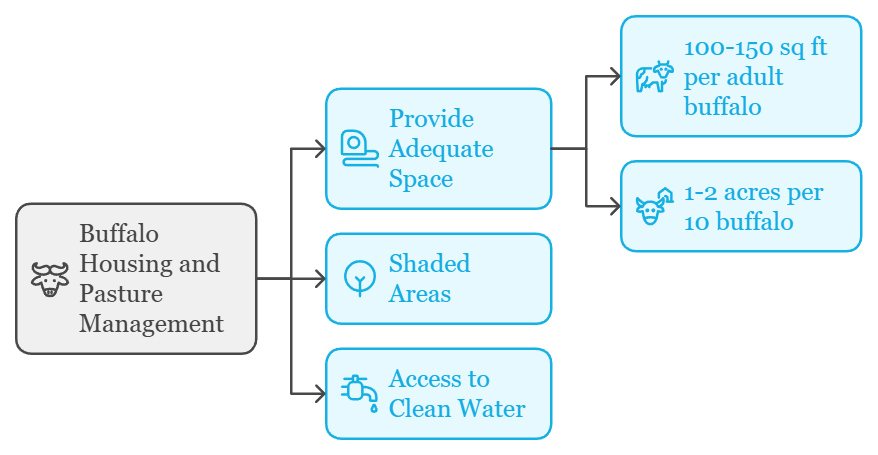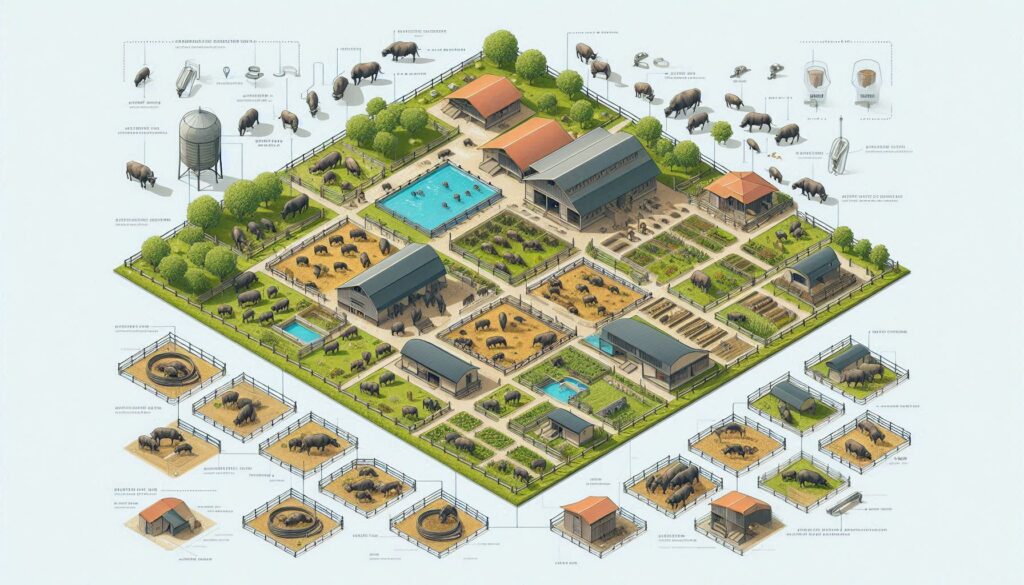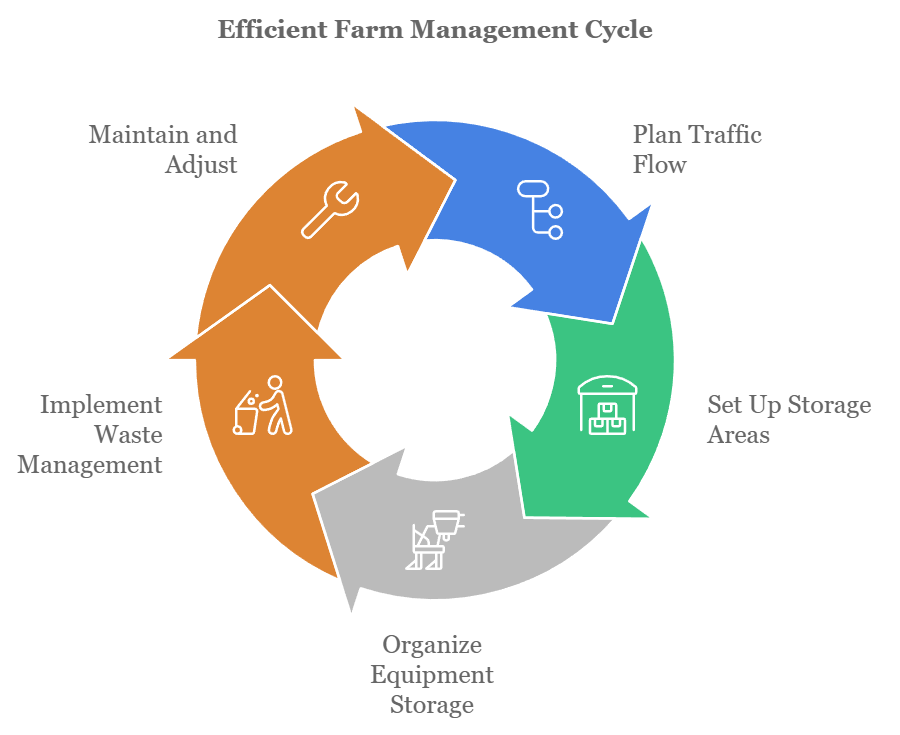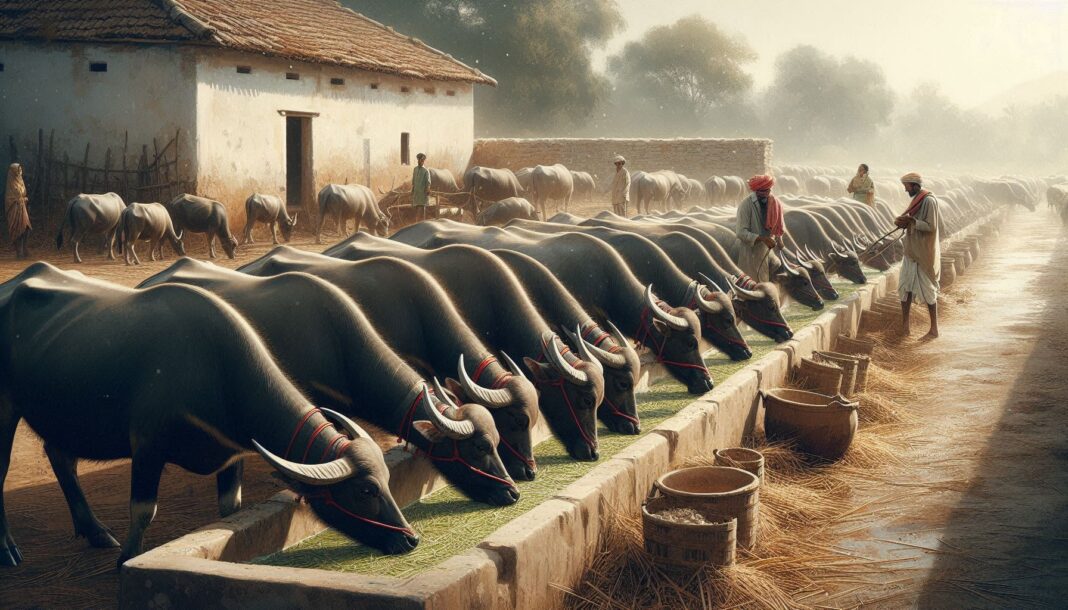When I redesigned my buffalo farm layout a few years back, I saw a whopping 30% increase in productivity! It’s not just about making things look pretty (though that’s a nice bonus) – it’s about creating a space that works for you, your animals, and your bottom line.
Understanding Buffalo Behavior and Needs

When I first started out, I made the rookie mistake of treating my buffalo like oversized cows. Boy, was I in for a surprise! These majestic beasts have their own unique needs and behaviors that you’ve gotta consider when planning your farm layout.
Buffalo are social animals. They love to hang out in herds, and they’ve got their own little hierarchy going on. I remember watching my first herd and thinking, “Huh, it’s like high school all over again!” You’ve got your leaders, your followers, and even the occasional rebel. When designing your layout, you need to give them enough space to maintain these social structures without causing stress.
A good rule of thumb is to provide about 100-150 square feet per adult buffalo in your housing areas. But here’s a pro tip: don’t skimp on the pasture! I learned the hard way that cramped buffaloes are grumpy buffaloes, and trust me, you don’t want to deal with a 2,000-pound grump. For grazing, aim for 1-2 acres per 10 buffalo, depending on your pasture quality.
Water access : Buffaloes might look tough, but they’re actually big softies when it comes to heat. I once saw my entire herd crammed under a single tree on a hot day – it was like a buffalo comedy show! Make sure you’ve got plenty of shaded areas scattered throughout your pastures. As for water, these guys can drink up to 30 gallons a day, so easy access to clean water is a must.
Essential Components of a Buffalo Farm Layout

Alright, now that we’ve got the buffalo basics down, let’s talk about the key ingredients of a well-designed buffalo farm. Think of it like making a perfect buffalo mozzarella – you need all the right elements in just the right proportions!
- Grazing pastures: This is where your buffaloes will spend most of their time. I’m a big fan of rotational grazing systems. It’s like giving your pastures a vacation – they get time to rest and regrow while the buffaloes munch on another section. Plus, it helps prevent overgrazing and keeps your land healthy.
- Feeding areas: Even with great pastures, you’ll need designated feeding areas. I like to place these near the center of the farm for easy access. Pro tip: make sure your feed storage is nearby to save yourself some back-breaking labor!
- Water sources: Remember those 30 gallons per day I mentioned? Yeah, you’re gonna need a solid water system. I use a combination of natural water sources (we’ve got a lovely creek running through the property) and strategically placed water troughs.
- Shelter and housing: Buffaloes are pretty hardy, but they still appreciate a good roof over their heads. I’ve got a mix of open-sided shelters for mild weather and more enclosed barns for when Mother Nature decides to throw a tantrum.
- Handling facilities: This includes your chutes, pens, and loading areas. Trust me, you want these to be top-notch. I once tried to wrangle a buffalo through a poorly designed chute, and let’s just say it ended with me taking an unexpected mud bath!
The key is to arrange these components in a way that makes sense for your specific property and herd size. It’s like putting together a giant, muddy puzzle!
Designing for Efficient Operations

Traffic flow: This isn’t just about your buffaloes; it’s about you and your equipment too. When I first started, I had my feed storage on one end of the farm and the feeding areas on the other. Let me tell you, those daily treks got old real quick! Now, I’ve got a nice central path that connects all the key areas, making it easy to move animals, machinery, and supplies around.
Storage : Your feed storage should be easily accessible but secure from curious buffalo noses. I learned this lesson the hard way when I found my entire herd had somehow opened the feed shed and were having an all-you-can-eat buffet. Not fun for their tummies or my wallet!
Don’t forget about equipment storage too. Keep your tractors, ATVs, and other machinery protected from the elements but close to where you’ll be using them most.
waste management : A good waste management system is crucial for keeping your farm clean and your buffaloes healthy. I use a combination of composting and spreading to turn all that manure into black gold for my pastures. Just make sure your waste management areas are downhill and downwind from your main living and working areas. Trust me on this one!
Remember, efficiency isn’t just about saving time (though that’s a big plus). It’s about reducing stress – for you and your buffaloes. A smooth-running farm is a happy farm!
Incorporating Animal Welfare in Your Layout

As buffalo farmers, we’ve got a big responsibility to ensure our animals are happy and healthy.
I can’t stress this enough (pun intended): well-designed handling facilities make life better for everyone. I use curved chutes and solid sides in my handling areas. It might sound odd, but buffaloes move more willingly through curved paths, and solid sides keep them from getting distracted or spooked.
Comfortable resting spaces : Buffaloes love to lounge! I provide a mix of open areas for those who like to soak up the sun and covered areas for shade-seekers. A layer of soft bedding in sheltered areas goes a long way in keeping your herd comfy.
buffaloes get bored! Providing enrichment areas can make a big difference in their well-being. I’ve got some sturdy scratching posts scattered around (old telephone poles work great), and I even installed a sprinkler system in one pasture for hot days. It’s hilarious watching a group of buffaloes play in the spray like oversized puppies!
Quarantine and medical treatment zones : When I first started, I didn’t have a dedicated area for this, and trying to treat a sick buffalo in the middle of the herd was… well, let’s just say it was an adventure. Now, you have to a separate, quiet area where I can isolate and treat animals when needed. It’s less stressful for the sick animal and safer for everyone involved.
Remember, a layout that prioritizes animal welfare isn’t just good for the buffaloes – it makes your job easier too. Win-win!
Adapting Your Layout to Different Climates
Buffalo are tough cookies, but even they have their limits when it comes to extreme weather. Your farm layout needs to be climate-smart to keep your herd comfortable year-round.
For those of you in hot climates (I’m looking at you, Rajasthan!), shade is your best friend. You’ve got shade structures scattered throughout the pastures, and I’ve planted fast-growing trees for natural shade.
Tip: position your water sources near shaded areas to encourage your buffaloes to stay cool and hydrated.
Ventilation is crucial too. Some farmers I know have even set up misting systems for those really scorching days. Just imagine a buffalo spa day!
Windbreaks are essential. You’ve used a combination of natural tree lines and artificial windbreaks to protect your herd from bitter winter winds. Your shelters need to be well-insulated too. I learned the hard way that a drafty barn is no one’s friend in the dead of winter.
But here’s the kicker – you need to plan for both hot and cold weather, no matter where you are. Climate change is making weather more unpredictable, so flexibility is key. I’ve designed my farm to have options for all seasons, and let me tell you, it’s been a lifesaver.
mud : A good drainage system is worth its weight in gold. I’ve graded my high-traffic areas and installed French drains to keep things from turning into a muddy mess. Trust me, your buffaloes (and your boots) will thank you!
Technology Integration in Modern Buffalo Farm Layouts

I thought, “What do these fancy gadgets know about buffalo farming?” But let me tell you, integrating technology into your farm layout can be a game-changer!
First up, automated feeding systems. I installed one a couple of years ago, and it’s like having an extra pair of hands on the farm. Your system should be is set up to dispense feed at specific times, which helps maintain a consistent routine for the herd. Plus, it’s positioned in a way that allows easy refilling and maintenance.
Smart fencing and animal tracking? Now we’re talking! I’ve incorporated GPS collars for your herd and linked them to a virtual fencing system. It sounds like sci-fi, but it’s real, and it’s amazing. you can monitor my buffaloes’ locations from my phone and even set up virtual boundaries. No more middle-of-the-night fence checks!
When it comes to surveillance and monitoring, strategic camera placement has been a lifesaver. You should have cameras overlooking key areas like the calving pens and main gates. They’re all connected to a central system that I can access from my phone or computer. It’s great for keeping an eye on things without having to be everywhere at once.
Integrated thoughtfully into your layout. Consider things like power sources, Wi-Fi connectivity, and protection from the elements when deciding where to place your high-tech helpers.
But don’t get so caught up in the tech that you forget the basics. Big mistake! Technology is a tool, not a replacement for good old-fashioned animal husbandry.
Scaling Your Buffalo Farm Layout

When I started, I had a small herd and big plans. Now, I’m living those plans, but let me tell you, scaling up can be tricky if you don’t think ahead.
Always design with the future in mind. When I laid out my initial farm, I made sure to leave room for expansion. It might have looked a bit empty at first, but boy am I glad I did it! It made adding new pastures and facilities so much easier down the line.
Consider a modular layout concept : Think of your farm like building blocks. Each section (pastures, handling facilities, feed storage, etc.) should be designed to function independently but also integrate seamlessly with future additions. This approach has saved my bacon more than once when expanding!
Plan your expansion in phases: When you decided to grow your herd, you can map out a five-year plan with clear stages. Phase 1 was expanding the grazing land, Phase 2 was upgrading the handling facilities, and so on. This way, I could grow sustainably without overwhelming myself (or your wallet).
Infrastructure as you scale: Upgrading your water systems, beefing up your fencing, and expanding your waste management capabilities. Plan for these less exciting but crucial elements from the start.
Final Thought
Whew! today we’ve really covered a lot, haven’t we? From understanding how our buffaloes behave to using the latest technology, planning a buffalo farm that’s both efficient and kind to the animals is no easy task. But believe me, getting it right is so worth the effort!
As we wrap things up, I want to stress how important a well-planned farm layout is for your success as a buffalo farmer. It’s not just about placing things here and there – it’s about creating a space where your buffaloes can thrive, your work flows smoothly, and your business can grow steadily. A good layout can boost your productivity, ensure your buffaloes are happy and healthy, and make your daily chores much easier. Trust me, your future self will thank you for the time and care you put into planning now!
So, take a moment to really look at your current farm setup. Is it working as well as it could? Are there areas where you can improve efficiency or take better care of your buffaloes? Maybe it’s time to think about how to adjust your layout for future growth or to handle changing weather conditions.
And hey, I don’t have all the answers. Buffalo farming is a journey we’re all on together, learning step by step. That’s why I’d love to hear from you! Have you come up with any smart solutions for your farm layout? Or are you facing some challenges that are hard to overcome? Drop a comment below and let’s chat. After all, we buffalo farmers need to support each other!




